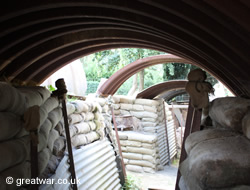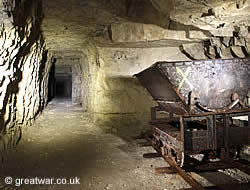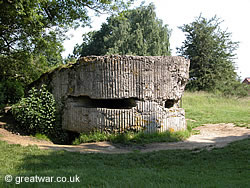Battle Remains on the WW1 Western Front
There are various types of battle remains to be found on the old battlefields of 1914-1918. Some battlefield remains can easily be seen in the landscape and which are characteristic of the type of trench warfare fighting on the Western Front. Other remains may not be so easy to find as, by the very nature of this type of warfare, a large part of the time was spent below ground level by the soldiers who fought in it.
- Clearing the Battlefields
- WW1 in Today's Landscape
- Bunkers & Strongpoints
- Equipment & Personal Possessions
- Mine Craters
- Shelters, Rails & Posts
- Trench Remains
- Tunnels
- “The Iron Harvest”
- Battle Remains to Visit on the Western Front
Clearing the Battlefields
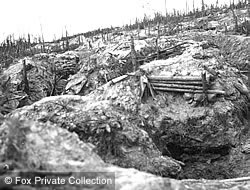
|
After 1918 the immense task of “clearing up” was carried out by the military and the civilians who were returning to their shattered communities.
The landscape in the fighting lines had been smashed to pieces. Roads, woods, farms and villages were often no longer recognisable. Local people who had been forced to abandon their homes and livelihoods were faced with the huge task of making a new start, rebuilding homes, businesses, farms, churches, public buildings, roads, bridges, railways and canals. The hazardous job of clearing abandoned weapons, battlefield debris, ammunition, filling in craters, tunnels, and, in many cases, exhuming soldiers' remains had to be carried out.
At official levels there were discussions as to whether some places should be left completely untouched. An idea to leave the whole of the ruined city of Ypres as a permanent British memorial to the Great War was not agreed to. Remarkably, within ten years of the end of the war roads and buildings had already been rebuilt and the city had begun to rise again from the devastated ruins.
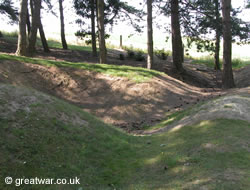
|
Some remains in the fighting zones were left untouched after the war for a variety of reasons. Some constructions were too heavily reinforced to be destroyed, some underground remains were closed off or allowed to flood, some land was too dangerous to clear, or some sites were simply so remote and unpopulated that they were left as they were.
Other sites were preserved intentionally by the landowner or officially as a memorial or place of historic interest. As the 1914-1918 war has grown more distant in time the important task of preserving and protecting existing or newly discovered remants of this period in history has been carried out by individuals and organizations, in a private and an official capacity.
WW1 in Today's Landscape
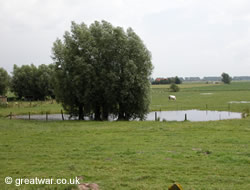
|
Battle remains of trench warfare in today's landscape are often immediately obvious in the form of cratered ground, large round holes in the fields or concrete constructions. In areas which are still very rural the damaged landscape is often exposed where the ground has not been developed or has been taken back to its original farmland.
Round ponds in farmers' fields are likely to be a large shell crater. Uneven, cratered grassy plots of land are probably ground which has been cleared but is not usable due to toxins in the soil or the difficulty and danger of levelling it out again. At certain times of the year before or after the crops are growing in the fields chalky topsoil can be seen to mark out trench lines or shell-cratered ground.
Bunkers and Strongpoints
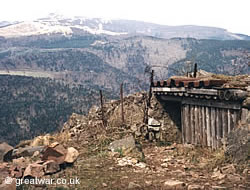
|
Reinforced concrete structures were built on both sides of the Front Line along the length of the Western Front. There are many examples to be seen which have survived in the landscape since 1918. Some are on private land but can be seen from nearby, others are possible to visit as a formal site of preservation and some are on public land with access at all times.
Equipment and Personal Possessions
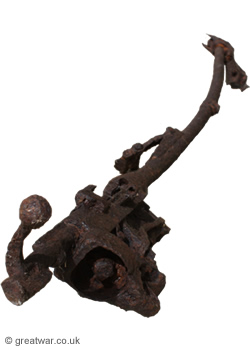
|
These sort of remains are likely to have been lost in the ground and occasionally are found when soil is disturbed by digging or ploughing. Metal items which have been preserved in the soil, such as buttons, badges, equipment such as water bottles, a razor and eating utensils, have been found in fields many decades after the fighting ceased. Many private and official museum collections have artefacts like these on show.
With the increased number of visitors to particular parts of the Western Front the edges of many fields and tracks have been well-visited and any battlefield “finds” like buttons or badges are rarely found there any more. There are, however, many remote and less frequently visited battlefield sites which probably still have many undiscovered remains to be found.
Having said this, visitors are strongly advised that picking items up from a battlefield area can be extremely dangerous. It should also be remembered that the Western Front battlefields still contain the human remains of many thousands of soldiers who have never been recovered and the ground should be respected for that reason.
Mine Craters
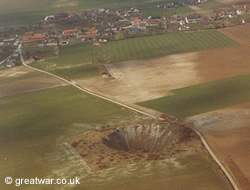
|
Offensive mine warfare was a characteristic of the fighting on the Western Front. There are many examples of small or large mine craters created by exploded underground mines.
The largest mine crater on the Western Front can be seen on the 1916 Somme battlefield in France. This is an example of a site of battlefield remains and historical importance, which was formally unpreserved and was “rescued” as a site of historical importance. For 50 years it had been left in the landscape, but had begun to be used by motorbikers and for dumped rubbish. It was privately purchased in 1979 and is now a recognized 1914-1918 historic battlefield site.
Shelters, Rails and Posts
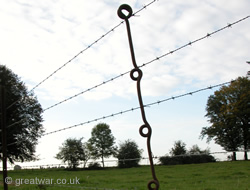
|
In rural areas abandoned corrugated iron sheets, railway tracks and British metal picket posts used to hold the barbed wire can still be seen where they have been “recycled” by farmers to make animal shelters and fencing.
Trench Remains
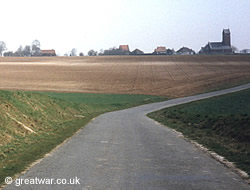
|
From the winter of 1914-1915 the entrenchment of the Allied and German Front Lines began along the length of the Western Front from the North Sea coast in Belgium to the Swiss border near Pfetterhouse.
There are a small number of places where sections of trench lines can still be visited. A few of these places are private or public sites with original or reconstructed trenches preserved as a museum or memorial.
Nevertheless, there are still remains of trenches to be found in remote parts of the battlefields such as the woods of the Argonne, Verdun and the mountains of the Vosges.
Tunnels
After the war many kilometres of underground tunnels which were dug on both sides of the Front Lines by Allies and Germans were filled in, covered over or allowed to flood.
Occasionally a deep dugout or tunnel has been discovered in recent years. More often than not the construction of an underground tunnel and the artefacts buried within it have been found to be well preserved. Battlefield archaeologists have found all sorts of fascinating items such as greatcoats hanging on their pegs, rubber gumboots, eating utensils and equipment boxes. WW1 graffiti is also a fascinting “find” as any inscriptions or drawings on the walls of the tunnels can help to identify the men who built the tunnels or who lived in them.
Some of the tunnels were built with the aim of laying an explosive charge at the far end in order to blow a mine under the enemy's position. This was treacherous work and many tunnellers from both sides of the Front Lines died in tunnel collapses, underground explosions and suffocation. In some cases it is known that the explosive charge did not go off, and these particular tunnels with their unexploded mines still pose a potential hazard today.
Visiting any WW1 tunnel on the battlefield is dangerous and a tunnel should only ever be entered by the public under supervision or where officially recognized as a visitors' site. There are some sites where tunnels have been made safe. As an alternative, there are museums which can offer visitors the experience of life underground in reconstructions of WW1 tunnels and deep bunkers.
“The Iron Harvest”
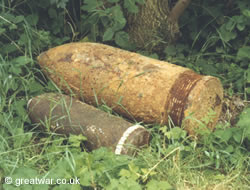
|
Visitors to the battlefields are advised that some battle remains are hazardous and care should be taken when examining any items found in the woods or fields. The urge to walk into a field and look for “rusty bits” like lumps of iron shell casing, shrapnell balls or bits of equipment can be hard to resist. However, even though the fighting in the area ceased over 90 years ago, there are still daily reports of WW1 ammunition and explosives found in the Salient.
Any current task which involves turning over earth, such as ploughing, road building, foundation building and so on, frequently still turns up a shell or grenade. There is a system in place in Belgium to deal with such potentially hazardous remains, whereby the “find” is reported, examined and collected for disposal. At certain times of the year when farmers are ploughing the fields it is not unusual to find small piles of shells at the side of a field placed ready for collection and disposal. In the regions of the old 1914-1918 battlefields where this happens it has become known as “The Iron Harvest”. Tractors can be fitted with armour plating underneath for the safety of the farmers.
Battle Remains to Visit on the Western Front
Sites in the battlefield sectors where battle remains are accessible for people to visit. Some are incorporated in museum or visitor centre sites:
Battle Remains & Museums at Antwerp, Yser/IJzer & the Belgian Coast
Battle Remains in the Ypres Salient
Battle Remains in the French Flanders and Artois Battlefields
Battle Remains on the Somme Battlefields
Acknowledgements
(1) Photograph courtesy of (the late) Bridgeen Fox, Colin Fox Collection.

